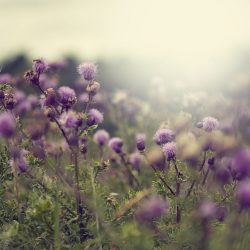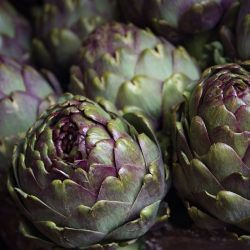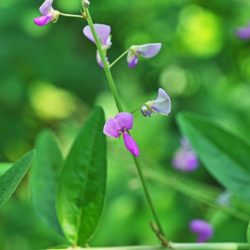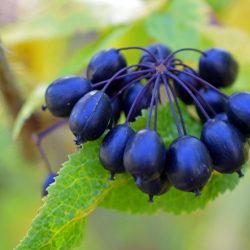Burdock, in addition to its medicinal implication in the daily life of men , has also been a plant linked to the spiritual domain. Already, 2000 years ago, Pliny indicated that it was one of the favorite plants of the Druids. Later, we will find it in the procession of solsticial plants and those that we throw (among others) into the fire during Midsummer’s Day in order to guard against the storm. Because they grow in the vicinity of humans, they have been said to be companion plants . Now let’s see how good company burdocks are from a medicinal point of view!
A little history
In the Middle Ages, it is found in Hildegard’s pharmacopoeia under the name “Cletta”. According to her, the root of the burdock is perfectly useless, preferring by far its leaves which she nevertheless indicates that they are dangerous for humans cooked as raw, except in rare exceptions: pectoral and respiratory pains, kidney stones. . It was only later, it would seem, that burdock met with great success as a topical skin disease , as it is still considered today.
It is then very popular, like the elecampane ( Inula helenium ), as a vulnerability and a remedy, in particular by external use on skin diseases (scrofula, scabies, leprosy, ringworm – of course! – sores, such as ‘indicates Albert the Great in the 13th century). It is also said to be diuretic, sudorific, detergent, pectoral and a little astringent, and intervenes in cases of lithiasis, coughing up blood, gout, arthritis, rheumatism, etc.
In the 16th century, the medicinal career of burdock took a new turn since it was thanks to decoctions of its root that we managed to cure King Henry III of large pox (syphilis). This new line on his CV confirmed his status as a panacea. In this, Lazare Rivière (1589-1655) will focus on the study of burdock because of its so-called antisyphilitic properties, while Olivier de Serres reports the other uses of his time (healing on ulcers, antivenom on snake bites and “other malignant beasts”).
What are the main pharmacological properties of Burdock roots?
Anti-infectious property:
Burdock is a nonspecific antibacterial in vitro against Bacillus subtillis, Escherichia coli, Shigella flexneri and S. sonnei, Pseudomonas aer. due to polyacetylene derivatives. It is also antistaphylococcal and antimycotic on Candida albicans .
Anti-inflammatory property:
Anti-inflammatory by arctigenin , by action on the production of NO and the secretion of pro-inflammatory cytokines (TNF-alpha, IL-6). Lignans, like diarctigenin , antagonize the platelet activating factor (PAF), involved in particular in the bronchospasm of anaphylactic shock or the inflammation of the acute allergic , by release of histamine and solicitation and call of eicosanoids (leukotrienes , thromboxanes, prostaglandins).
In vivo , burdock root powder decreases intestinal inflammation in colitis (by lowering IL-6 and TNF-α). Likewise, burdock stimulates the activity of macrophages.
In humans, infusion of A. lappa root improves the inflammatory state and oxidative stress in particular in patients with osteoarthritis of the knee.
Property on carbohydrate metabolism:
Anti-diabetic by lignans, burdock is hypoglycaemic by inhibition of alpha-glucosidase, and thus increases tolerance to carbohydrates. Confirming the traditional use of burdock root to reduce hyperglycemia, studies have shown that this plant also limits the rise in blood sugar after ingestion of carbohydrates, by its inulin ratio and by activating signaling intracellular energy metabolism (AMPK).
Hepato-protective property:
Thanks to its sesquiterpene lactones and its anti-free radical properties, burdock protects liver cells from damage caused by hepatotoxic substances such as ethanol, carbon tetrachloride, acetaminophen and paracetamol.
Nephroprotective property:
Burdock protects the kidney in vivo against the genotoxicity induced by cadmium.
Regulatory property of secretion and elimination functions:
-
Sudorific, sebum-regulating action:
Skin regulation of sebum secretion and promotes the maturation of the abscess and the elimination of pus (traditional use).
-
Choleretic and diuretic action:
Traditional use confirmed by studies indicating that the alcoholic acids of the root increase hepatic choleresis, exert an intestinal laxative effect and a renal action of uricorusic aquaretic and anti-urolithiasic type by alkalinization of the urine.
Antimutagenic, antitumor and anti-autoimmune properties:
The arctigenin contained in Arctium lappa is a pharmacologically active substance which confers neuronal protection and has antidiabetic, antitumor and antioxidant properties.
A 2015 study shows that arctigenin inhibits Th17 cells and improves experimental autoimmune encephalomyelitis , demonstrating anti-inflammatory and immunosuppressive properties. This indicates that it could be a potential therapeutic drug for multiple sclerosis or other inflammatory autoimmune diseases.
Antioxidant property:
This antioxidant activity results from the capacity demonstrated in vitro and in vivo of burdock to scavenge free radicals, and to increase endogenous antioxidants such as glutathione.
Are there any precautions for use with Burdock?
Contraindications:
- According to the EMA, as a precautionary principle, the use of burdock is not recommended in pregnant women (oxytocic properties, that is to say utero-stimulating) or breastfeeding.
- Reserved for adults
- Do not use in cases of hepatic colic or renal colic attack due to its choleretic and diuretic effects
Precautions for use:
- Risk of allergic reactions, probably due to its sesquiterpene-lactones. Caution in case of pre-existing allergy to plants of the Asteraceae family.
Drugs interactions :
Like all substances containing active ingredients , the risk of drug interactions must be taken into account.
Burdock is no exception to this rule, here is the list of drug interactions to consider :
- Dosage to be adjusted in case of taking antidiabetic drugs
- Avoid in combination with hypoglycemic agents
- Risk of drug interactions with anticoagulants and synthetic diuretics
How to take Burdock and in what dosage?
Dry form:
- As a food supplement (standardized extract of fresh plant, dry extract, powder in the form of tablets or capsules , or in bulk in sachet up to 500 g of powder) at a rate of 200 to 600 mg per dose, 2 or 3 times per day .
Liquid form:
- Standardized fluid extract of fresh plant : 5 to 10 ml per dose, 1 to 2 times per day in water.
- Full suspension of fresh plant : 5 to 10 ml per dose, 2 to 3 times per day in water.
- Hydroalcoholic fluid extract, mother tincture : 30 to 50 drops per dose, 2 to 3 times per day in water.
- Decoction of dried roots : 1 to 2 g per cup, to drink 3 times a day. In local application, possibility of using compresses soaked in a more concentrated decoction (25g of root in 1/2 L of water.
In local use: Burdock extracts can be used in the composition of creams, lotions or magistral preparations for local use.
Burdock in masterly preparation of standardized extracts in liquid form (EPS)
Association with Wild Thought :
To treat dry or itchy eczema, as well as dry dermatitis.
Association with Plantain :
To treat oozing or itchy eczema, as well as eczema associated with asthma and dermatitis.
Association with Echinacea :
To treat folliculitis as part of a metabolic syndrome, as well as staphylococcal infections (furuncle, superinfected eczema).
Association with Cypress :
Indicated in viral eruptive diseases (herpes, chickenpox, infantile roseola, Molluscum contagiosum ).
Association with Liquorice :
In the treatment of digestive and cutaneous candidiasis.
Association with black radish :
Indicated in dyshidrosis of the extremities, dermatitis in relation to hepatic fragility or for a need for detoxification (example: metabolic or medicinal).
Association with Nettle root :
As a treatment for maculopapular acne ‘florida’ on the face and back of adolescents.
Medical bibliographic sources and clinical trials :
- Maghsoumi-Norouzabad L, Alipoor B, Abed R, Eftekhar Sadat B, Mesgari-Abbasi M, Asghari Jafarabadi M. Effects of Arctium lappa L. (Burdock) root tea on inflammatory status and oxidative stress in patients with knee osteoarthritis. Int J Rheum Dis. 2016
- Zhao F, Wang L, Liu K. In vitro anti-inflammatory effects of arctigenin, a lignan from Arctium lappa L., through inhibition on iNOS pathway. J Ethnopharmacol. 2009
- Xu Z, Wang X, Zhou M, Ma L, Deng Y, Zhang H, Zhao A, Zhang Y, Jia W. The antidiabetic activity of total lignan from Fructus Arctii against alloxan-induced diabetes in mice and rats. Phytother Res. 2008
- Miyazawa, Mitsuo & Yagi, Nobuo & Taguchi, Katsuya. (2005). Inhibitory Compounds of .ALPHA.-Glucosidase Activity from Arctium lappa L
- Song-chow Lin. Hepatoprotective Effects of Arctium Lappa on Carbon Tetrachloride- and Acetaminophen-Induced Liver Damage
- Iwakami S, Wu JB, Ebizuka Y, Sankawa U. Platelet activating factor (PAF) antagonists contained in medicinal plants: lignans and sesquiterpenes. Chem Pharm Bull (Tokyo). 1992
- Li W. et al., Arctigenin Surpress Th17 Cells and Ameliorates Experimental; Autoimmune Encephalomyelitis Through AMPK and PPAR-y / ROR Signaling, Mol Neurobiol., 2015
- El-Kott AF et al., Use of Arctium lappa Extract Against Acetaminophen-Induced Hepato-toxicity in Rats, Curr Ther Res Clin Exp., 2015
- Suliman Al-Gebaly A., Ameliorative Effect of Arctium lappa Against Cadmium Genotoxicity and Histopathology in Kidney of Wistar Rat, Pak J Biol Sci., 2017
- Maghsoumi-Norouzabad L. et al., Effects of Arctium lappa L. (Burdock) root tea on inflammatory status and oxidative stress in patients with knee osteoarthritis. Int J rheum Dis., 2016







